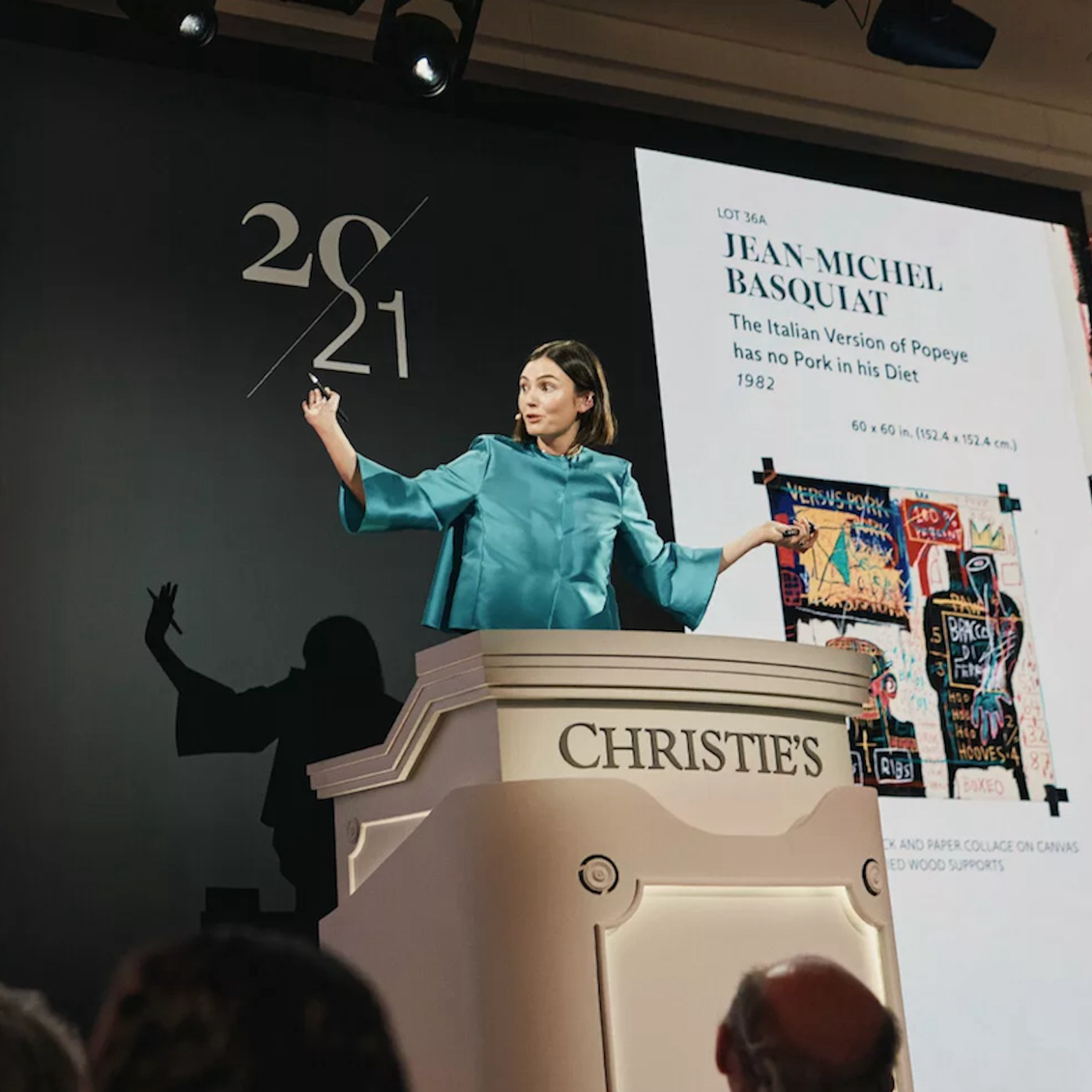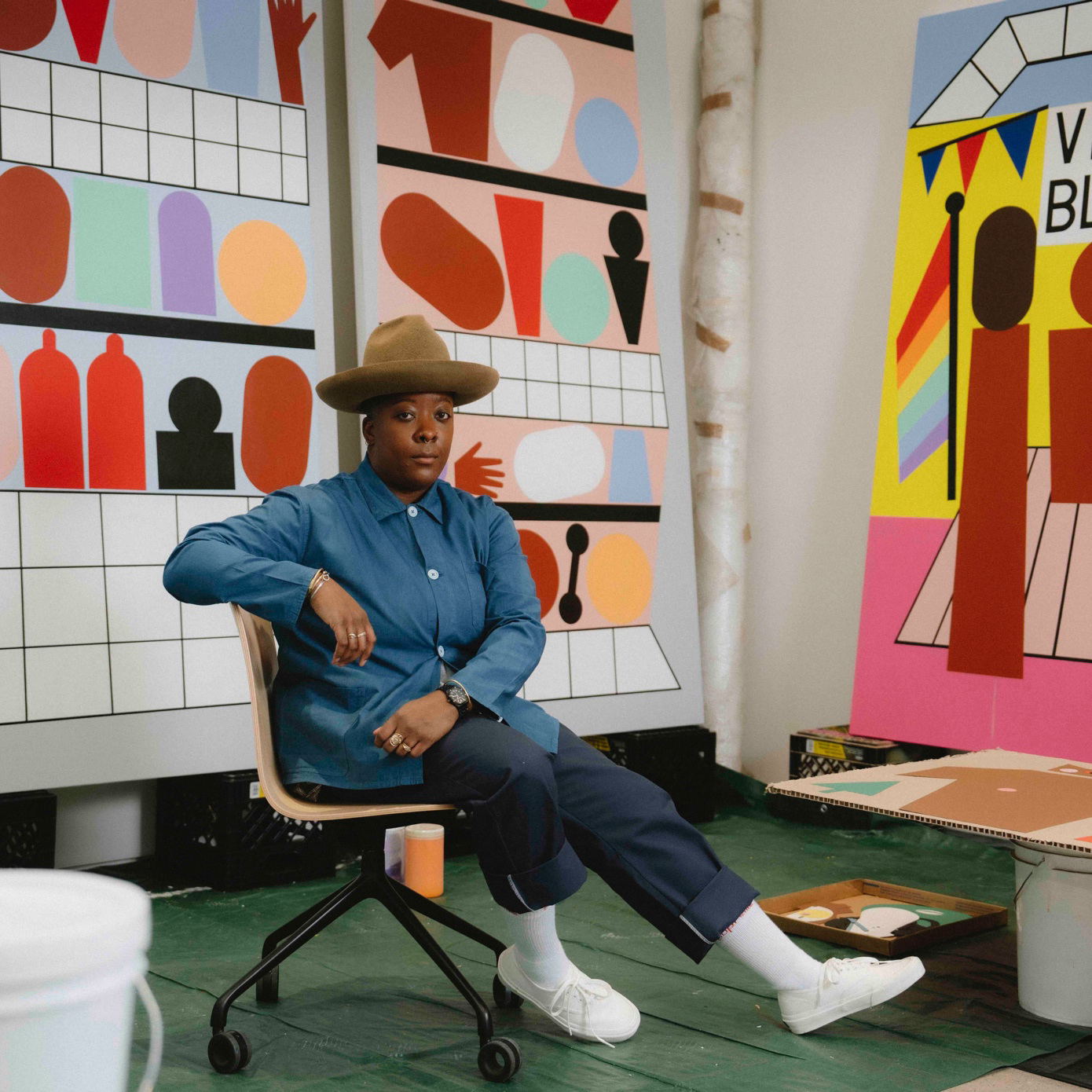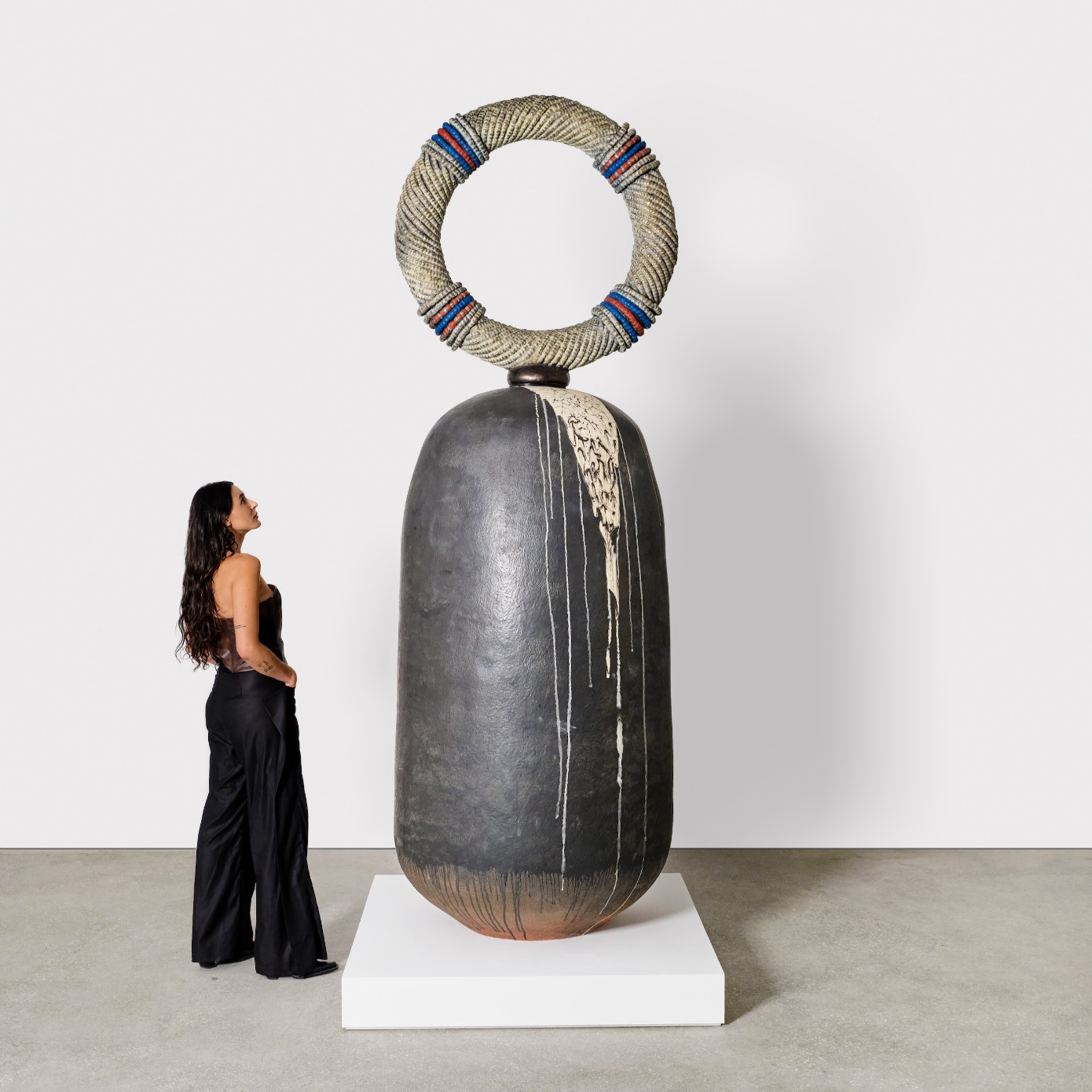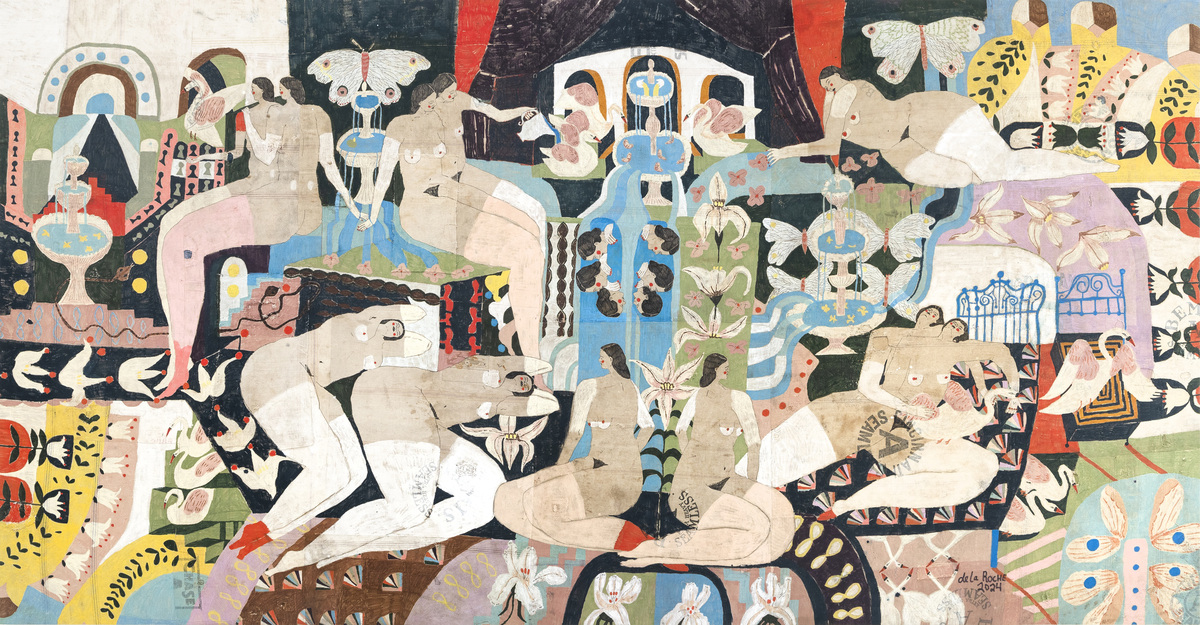
Lauren dela Roche is growing, literally. In preparation for her first New York solo show, on view at Eric Firestone Gallery through June 15, the Missouri-based artist shut herself in the studio for months, working away at the dense feed-sack frescoes she is making her name with. Her one extracurricular? Weightlifting. “My whole life I have tried to be really small, like physically really small,” she tells me over the phone. “I’ve tried to restrict my eating and never gain weight. I'm trying to take up space for the first time in my life. And I think that's the only reason I was able to make a big painting.”
The exhibition indeed hosts dela Roche’s most monumental work yet: Infinity Pool, 2024, which comes in at just over 14 feet wide. But the artist has long trafficked in the larger-than-life. Take the giantesses who populate her canvases, alternating through states of repose and unperturbed rapture, surrounded by schools of fish, swans, clubs, and all matter of flora. Or her artistic origin story, which involves a stint harvesting sugar beets in North Dakota, studio visits in a trailer, and coming out in a Pentecostal cult. The Eric Firestone show’s title, “No Man’s Land,” also makes room for a string of interpretations. The male presence is clearly omitted in dela Roche’s works, and its negation beckons the kind of lawlessness that the titular phrase engenders. It also refers to the discarded and overlooked trenches of life, which the artist engages in recovering the obsolete cotton feed-sacks she paints on.
To discuss these dynamics and more, dela Roche sat down with CULTURED. Here, the self-taught creative talks rural isolation, secret queer relationships, and side-chick practices.
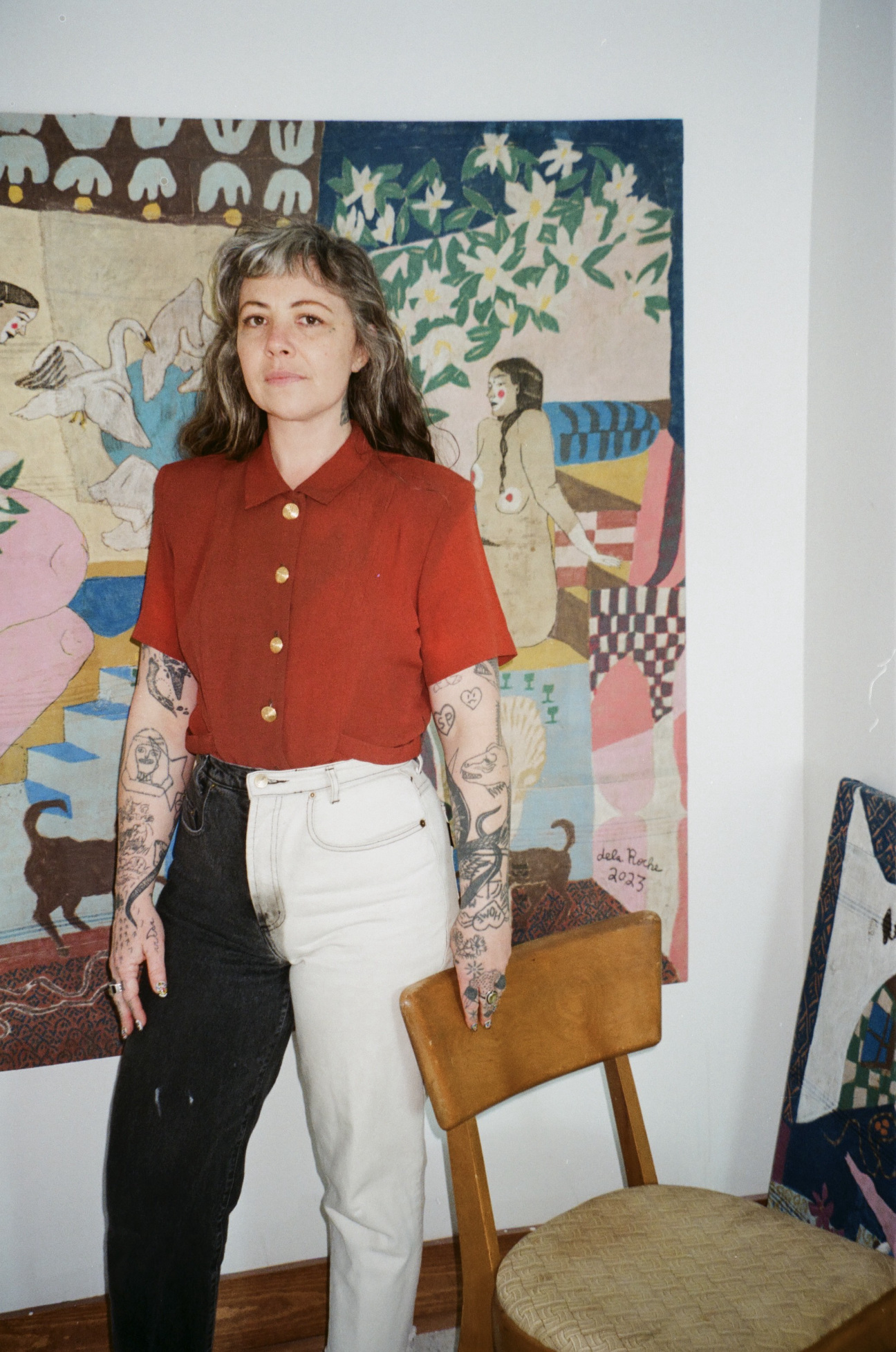
CULTURED: When did the conversation around this show with Eric Firestone begin?
Lauren dela Roche: I started working with Eric Firestone about a year ago. He took me to a couple of different art fairs in that time period and showed me at his space in East Hampton in a group show, and then he took me to Art Basel Miami Beach and showed me at his booth there. I did a pretty big piece for that show and a handful of smaller pieces. He had a really good response from them. I met with him two days after Basel opened, and he was like, “We have to do a solo, like, really soon.”
That was in December, and of course I didn't have any work at that time because I just had given it all to him for Basel. So it’s been five months [of making work for the show]. I've been pushing myself so hard in the studio and I'm really, really excited to see everything up on the walls and experience it alongside people. I live 30 minutes outside of Saint Louis in a pretty small town on a dead end street, and I honestly only see one to two people a day. I've always been a pretty isolated person; most of my life I've lived in rural areas. But I didn't really do anything else during this time period. My sister had a baby, and I was like, “I'll see your baby on my way to New York.”
CULTURED: In this hermetic ecosystem, what were you surrounding yourself with? Did you feel like something new was brewing in your work?
Dela Roche: I think of my creative process as being like a fermentation crock: I'm always inoculating new yeast and fighting off different bacteria and scooping out different molds. With this body of work, I'm working with these antique feed sacks I've been sourcing for a couple years now. They’re these old grain sacks that started being produced in the late 1800s during the boom of industrialized agriculture in the U.S. I found the very first one at the bins, which is where I go to clear my head and find all my clothes. The bins are the pay by the pound, sift through big piles of clothes type place. I found a feed sack there, and it was full of all these crazy repairs and all these intricate details. I was just so taken by it. This was maybe two years ago. Then my partner and I formed a line making clothes out of them. We would go out to different farms and buy them from people's barns.
Some of them were just too special; I just didn't want to make clothes out of them. I was stockpiling those, and then I started making paintings on them. It really opened up this new portal for me and my connection to narrative imagery and folklore and mythology—and mythology as metaphor. Then I discovered the BlindBoy Podcast, and I just pretty much only listened to that the entire time I made this body of work. He's an Irish podcaster. A lot of people in the U.S. don't know who he is, but he's actually really big in Ireland. He does a ton of stuff on mythology and a lot of Irish mythology, and he's really into talking about biodiversity and the history of farming. I’ve also been looking at Bob Thompson and Chris Johanson's work a lot.
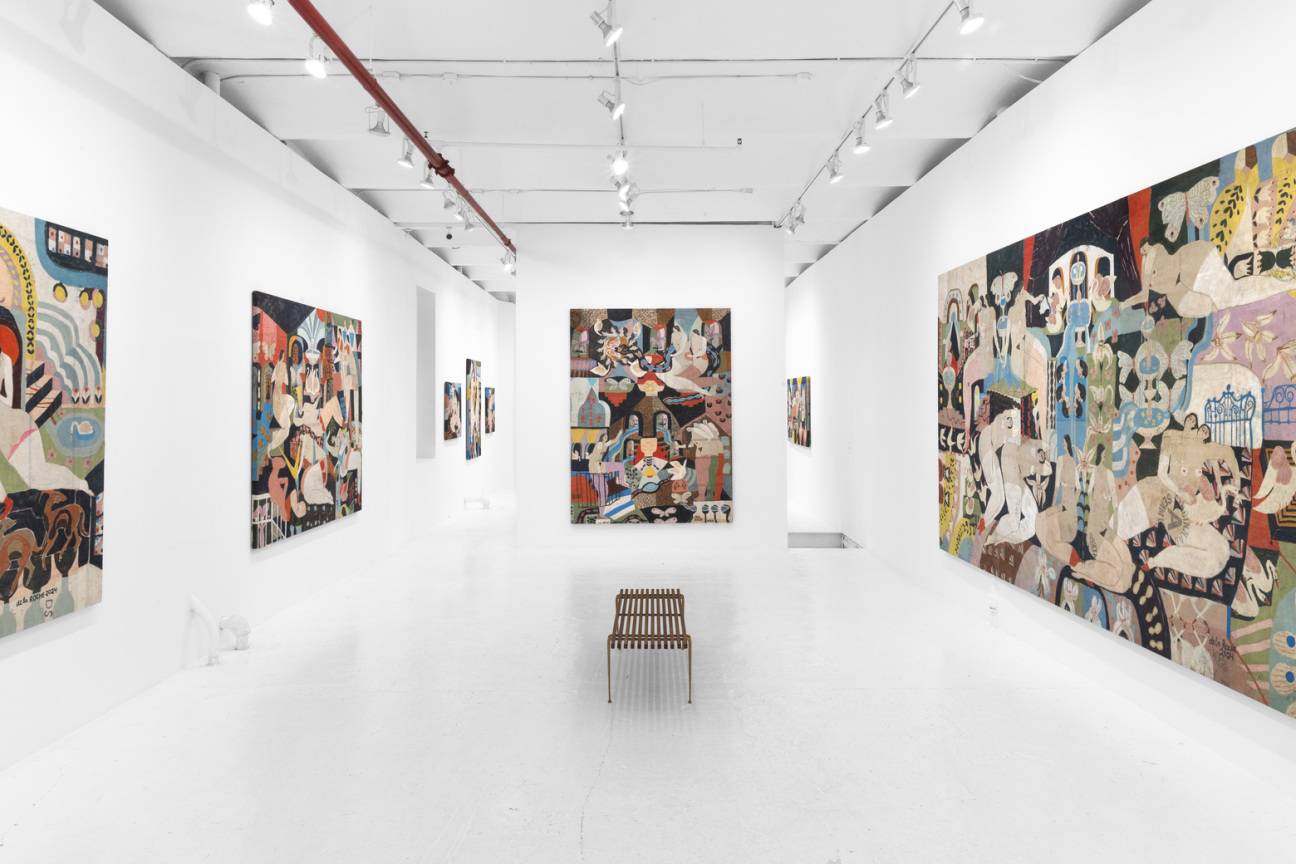
CULTURED: Agriculture seems to be quite the throughline in your artistic journey. I read that you began making work when you were harvesting sugar beets in North Dakota, almost 15 years ago.
Dela Roche: Yeah, when I was 28 or 29, I was working that seasonal job, which sounds like a farming job but is actually very industrial. You go to this big factory and operate the machinery where the big trucks come and dump off the sugar beets. The machinery piles the sugar beets, which are literally the size of your head, into miles and miles of these huge mountains, which get turned into sugar somehow. It's this very American job; if you're there for five years you get a pound of sugar as a little treat. I did it for three or four years. That year, I was there with my friend Ty Kerr, who is a practicing artist and super influential person in my life. We were sharing this tiny trailer in the campground, and we had all this time off before we started work. We were like, “Let's just drink tequila and draw together.” I was so shy about drawing in front of anyone, but he really made me feel comfortable doing that.
Soon after he encouraged me to apply for this emerging art grant called the Jerome Hill Artist Fellowship. You just send in images; you don't have to have a resume or anything. I dropped out of high school, so I didn't have any kind of experience to put on a resume. He was like, “Anyone can apply, and it's unrestricted funds, and you get a show at MCAD, which is the art school in Minneapolis. You get visiting curators and you get your foot in the art world door basically.” I applied for it, not really knowing what any of that stuff meant, except that I got $10,000 if I won. I did the studio visit in the trailer, in someone's backyard. I remember the night I got it I was at work, serving at a restaurant. A friend came in and was like, “No one who hasn't gone to art school has ever gotten that grant. I'm so proud of you.” And I just was like, “Oh really?” I had no idea.
CULTURED: You're a self-taught artist, and you're based in the Midwest. With the kind of critical distance that you have now from those early moments, what do you think both of those things afforded you, and what challenges have they brought?
Dela Roche: I think about that all the time. When I was living in Minnesota, I was showing with Bockley Gallery. I was also working at this restaurant like 40 hours a week. I ended up having a pretty severe work-related back injury and getting into a legal dispute over it. That was at the exact same time that I got the Joan Mitchell Grant. I realized I could potentially take this opportunity to create a life for myself as an artist. I started serving when I was like 16, and I was like 37 when this happened. So I just was like, “What am I gonna do? This is my one chance to try to make it as a self-employed artist.”
That really is what I chose to do with that little chunk of money: buy a cheap house, stay in the Midwest, and just use that resource. I have pretty much unlimited time now, and I have no idea what my practice would look like if I didn't have that time to consistently be able to make mistakes. Because I'm self-taught, the way I approach my practice is very risk-oriented. I have to take a risk to get the reward afterwards. I don't know how I would take those risks without the time to take the risk.
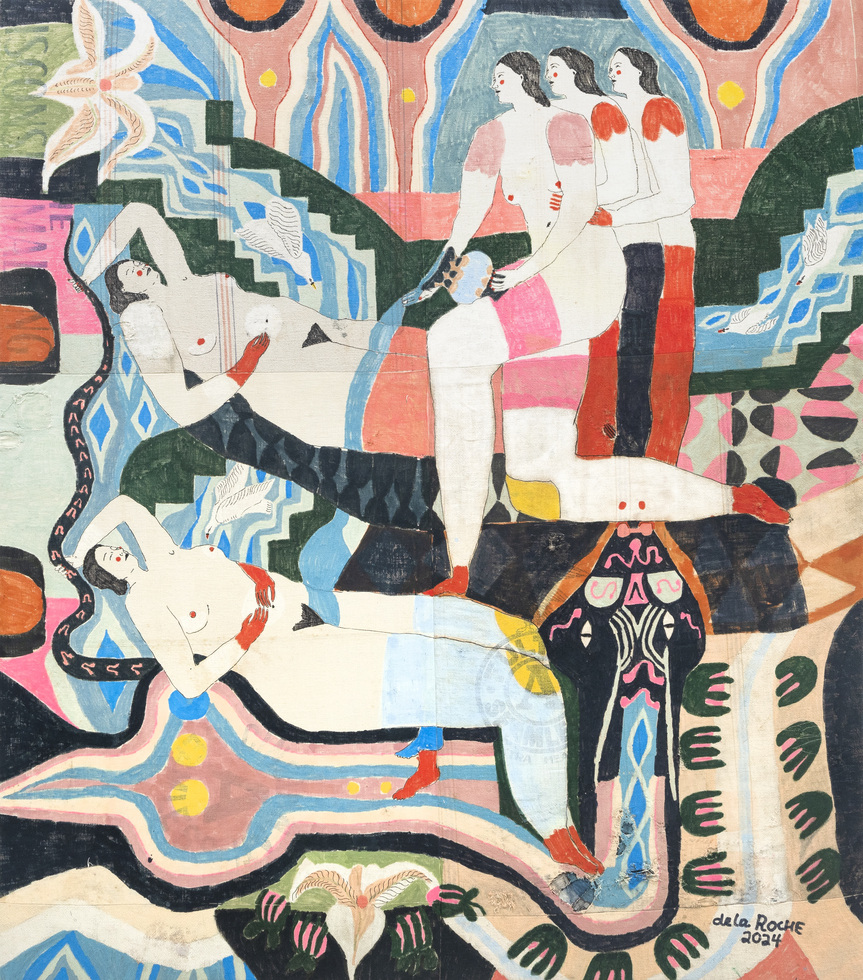
CULTURED: Another throughline in your work has been the female figure, which is obviously such an archetype in art history. What keeps you coming back to it?
Dela Roche: I've been drawing women forever. That's the first thing I started drawing when I was probably like 13 or something. It holds the most meaning and the most weight in the painting for me because it's the anchor. It's what sets the tone for the entire piece: Everything interacts with that form. But it isn't necessarily a specific woman. It's more of this symbol of agency and power. There's vulnerability in the power, and that's what I really strive for consistently with the female form. It definitely dates back to my most formative years, and figuring out my sexuality.
When I was 15 or 16, I dropped out of high school, came out as gay, and met this girl on the street that I fell in love with. I went back to her house and found out that she was in this Pentecostal cult. To be with her, I had to be in the cult; I was very scared of it but also kind of intrigued, so I ended up doing that for like two years. I was in this secret queer relationship, had no contact with my parents, and was getting the gay demons cast out of me.
CULTURED: You were getting the gay demons cast out of you while you're in a queer relationship with one of the people in the cult?
Dela Roche: Yes! I was psychologically getting very confused and also really excited about what was going on in the outside world and obsessed with what was gonna happen. That time period in my life created this little wormhole in my brain of what power and agency and femininity and all this other stuff can look like, and it's very separate from sexuality because of this church-religion situation too.
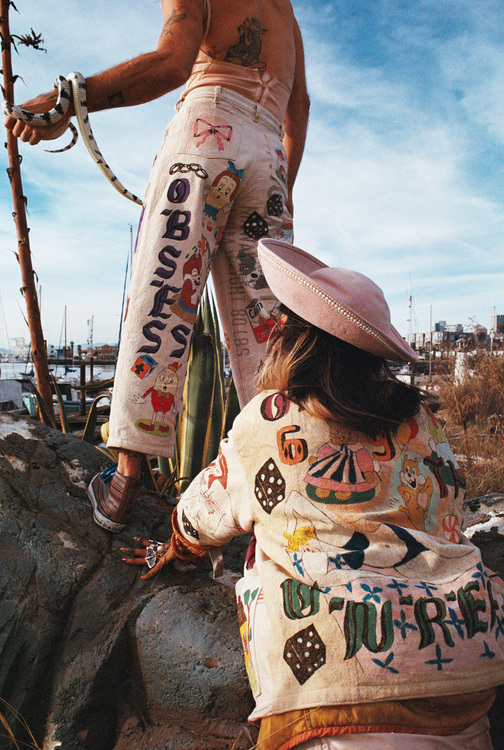
CULTURED: We touched on the feed sacks and your artistic practice, and you mentioned using them in the clothing line you run with your partner Curtis Campanelli, 69 Tearz. How has making clothes informed the paintings, and vice versa?
Dela Roche: It all started when Curtis and I were at a residency in Bed Stuy, and he was making clothes out of feed sacks. He wanted me to draw on some just to play around. He was like, “Don't worry, you don't have to show anyone.” That really got me going. Then he posted a picture of them on Instagram, and I was like, “Take that down.” But of course everyone was like, “What? These are crazy.” We're just total hermits, so getting just a little bit of interaction with people over posting something online was exciting.
I'm channeling some pretty intense stuff when I'm creating paintings or drawings, but it doesn't have to be that heavy all the time. That playfulness of creating clothes and having a little bit of conversation with people about it definitely opened me up to just being more open to vulnerability in my own practice. It changed my whole approach to how I look at it. It’s kind of like having a side chick: The serious relationship gets more attention when I'm in the studio because I get to have fun in this other relationship.
"Lauren dela Roche: No Man's Land" is on view at Eric Firestone Gallery 40 Great Jones St in New York through June 15.

